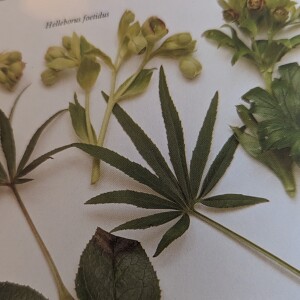 Not everyone gets excited about an evergreen, perennial plant with pale green flowers and a questionable fragrance. Still, times being what they are, anything that is alive, blooming and not related to politics is a cause for celebration. That is why I am so delighted to see the “stinking hellebore” or Helleborus foetidus preparing to bloom in my back garden.
Not everyone gets excited about an evergreen, perennial plant with pale green flowers and a questionable fragrance. Still, times being what they are, anything that is alive, blooming and not related to politics is a cause for celebration. That is why I am so delighted to see the “stinking hellebore” or Helleborus foetidus preparing to bloom in my back garden.
Some plants have lovely, evocative common names like “kiss-me-over-the-garden-gate”. Other common names are biblical, like “Jacob’s ladder.” Some even shade towards the lascivious, like the lovely Chinese peony that I saw advertised some time ago. Its name allegedly translated to “tipsy imperial concubine”.
Helleborus foetidus’ common names are purely descriptive—possibly a little too much so. At various times and in various places it has been known as “stinking hellebore”, “stinkwort”, and “dungwort”. “Bear’s foot hellebore”, which describes the shape of the leaves rather than the scent of the flowers, is a little less disagreeable.
So what is all the unpleasant hyperbole about? Helleborus foetidus is a medium-size plant, growing one to two feet tall and about a foot wide. Its thick, branching stalks give rise to individual stems bearing numerous, deeply dissected leaves that are generally medium to dark green. Round, pale green buds appear at the tops of the stems, surrounded by protective leaf collars. In my garden, those buds are ripening rapidly right now, and if the weather cooperates, they should open into five-petaled flowers as early as Valentine’s Day.
The flowers look like green buttercups, which is logical, since all hellebores, stinking or not, belong to the Ranunculaceae or buttercup family. The blooms do not have a pronounced fragrance, though you will get a whiff of the characteristic foetidus odor when you cut a stem.
“Stinking” is an overstatement, at least to my nose. The smell is not skunky or sulfurous like rotten eggs. It is hard to characterize, but it is just unpleasant enough to tell you that you should not crush plant parts or put your nose too close to cuttings.
The silver lining to the malodorous Helleborus foetidus cloud is that deer and other garden varmints find the scent completely unappealing. If you plant a stinking hellebore, nothing will disturb it unless you inadvertently lop it off with your string trimmer.
Though the stinking hellebore has been grown in North America since at least the early 1800’s, it is not native. Western Europe is its home stomping ground, and most likely it arrived with early colonists and took hold in their gardens. “Took hold” is probably an understatement, since the plants are prolific and self-seed readily.
I believe that I planted a single specimen an indeterminate number of years ago, and the garden has never had less than ten plants since then. They hold up well through the winters, and start blooming any time from the end of January in mild years, to early March in years when winter is severe.
Stinking hellebore is harder to find commercially than its more popular and less stinky relatives, Helleborus niger, the “Christmas rose”, and Helleborus x orientalis, the “Lenten rose”. Its relative lack of popularity also extends to plant breeders, but one variety ‘Wester Flisk’, is sometimes offered by retailers. Bred in Scotland, ‘Wester Flisk’ bears slender, gray-green leaves, and features red-tinged stalks and stems. The slightly nodding green flowers may also be a bit red around the edges.
I haven’t grown this variety, but the appearance—especially of the leaves–seems more refined than that of the species.
Stinking hellebores like a shady spot, consistent moisture and, if possible, a little protection from cold winds. In groups the plants make decent evergreen ground covers, though in truth, I prefer Helleborus orientalis for that purpose. Like other hellebores, the plants’ appearance benefits from removal of the tatty year-old foliage.
We all know, and may even be related to, people that are like Helleborus foetidus—generally acceptable, but with a single off-putting trait. I can overlook the stinking hellebore’s one off-putting trait because of the excitement I feel when I see the flower buds in spring. While the crocuses and snowdrops shine in diminutive splendor, the hellebores stand tall and proud, ready to take on the world. That trumps a little unpleasant odor any day.
You can find ‘Wester Flisk’ at Digging Dog Nursery, 31101 Middle Ridge Road,
Albion, CA 95410; (707) 937-1130; wwwdiggingdog.com. Print catalog available.
